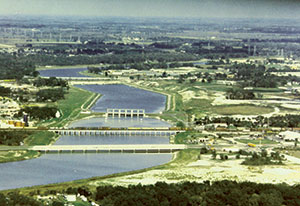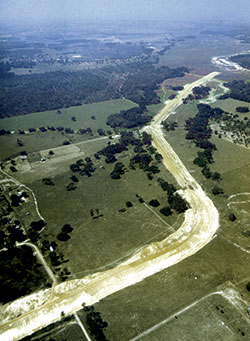As the District stepped into its second decade, the hints of change that began in the late 1960s moved to the forefront.

One of the District’s largest flood control systems, the Tampa Bypass Canal and its flood control structures, became fully operational in the 1970s.
The flood protection mission that sparked the District’s birth continued on schedule. By 1970, major flood protection projects were complete, or nearly so in Pinellas, Citrus, Hernando and Pasco counties. The Tampa Bypass Canal, by far the District’s largest flood control project, was well under way. In 1971, aerial mapping and floodplain delineation programs began in earnest.
But dry years plagued the region, following on the heels of 1960’s Hurricane Donna, returning in the mid-1960s and again in 1970. Florida’s population grew from 4.9 million in 1960 to 6.8 million by 1970. New residents and more industry were increasing demands on the state’s water supply.
As damage to the natural environment became more and more evident, state leaders took action. Four major pieces of legislation were enacted by the 1972 Legislature: the Water Resources Act, the Environmental Land and Water Management Act, the Comprehensive Planning Act and the Land Conservation Act. These laws are based on the philosophy that land use, growth policy and water management cannot be separated, a theme that continues to this day.
Water Resources Act
Until 1972, only two water management districts existed: the Southwest Florida Water Management District and the Central and Southern Florida Flood Control District, the predecessor to the South Florida Water Management District. The Water Resources Act established six water management districts, encompassing the entire state, and created policymaking boards for each district. The act also authorized district regulation of well construction, management and storage of surface waters, and consumptive use of waters of the state. The Legislature provided a funding mechanism for the new districts as well. Those six districts became the current five in 1975 when two were combined to form the South Florida Water Management District. A constitutional amendment, passed by statewide referendum in 1976, granted ad valorem taxing power to the water management districts.

One of the District’s largest flood control systems, the Tampa Bypass Canal and its flood control structures, became fully operational in the 1970s.
The Southwest Florida Water Management District was already involved in water use regulation and water supply planning, but the act formalized water management district roles in public law from strictly flood control to a more broad-based policy of resource management and service to the public.
Don Feaster was the District’s executive director from 1972 to 1981, and he saw the District’s growth firsthand.
“Before the Water Resources Act was passed, we had already begun regulating wellfields,” said Feaster. “The act gave us statutory authority to do what we had already been doing.”
Diminishing groundwater resources wasn’t a new problem for the region in the 1970s. Feaster remembered talking to local people who said the water problems had started in the 1930s when St. Petersburg drilled wells in Hillsborough County.
“Although most of our budget was for flood control projects,” said Feaster, “the previous executive director, Dale Twachtmann, believed regulating groundwater withdrawals was our greatest challenge.” The Water Resources Act went beyond flood control and groundwater regulation, defining four areas of responsibility for the state’s water management districts: flood protection, water supply, water quality and natural systems management. Following up on the new statutory direction, the District expanded its regulatory program into a consumptive use permitting program that encompassed the entire District.
Green Swamp Protection
The Environmental Land and Water Management Act provided for state designation of Areas of Critical State Concern. These areas are accorded greater state oversight of planning and land development regulation because of their important environmental significance. The Green Swamp is one of four such designated areas in the state.
Green Swamp lands were initially purchased to convert them into a series of flood detention areas. Later, the District took a nonstructural approach to flood protection by leaving the Green Swamp in its natural state. The Green Swamp has the ability to store surface water and slow the flow of floodwaters while sustaining rivers and streams. The makeup of the Green Swamp puts pressure onto the aquifer, helping to push water through to the Gulf of Mexico. The water flowing from the Green Swamp is generally of higher quality than other watersheds. This is due to the Green Swamp being largely undeveloped as well as its lengthy surface water detention time.
Conservation and Planning
The Land Conservation Act established a land acquisition program to conserve and protect environmentally endangered lands in Florida and authorized the sale of state bonds to purchase them. Florida citizens approved a constitutional amendment authorizing $240 million in state bonds for the Department of Natural Resources to purchase environmentally endangered lands.
The Comprehensive Planning Act asserted a state interest in state and local planning, requiring the state to prepare a state plan. The Legislature later rejected the submitted plan, but the stage was set for state oversight of development.
All the attention on environmental issues in the 1970s gave the District a higher profile than it had enjoyed in its first decade. According to Feaster, that helped keep the organization on an even keel. Before the District had taxing authority, the fight for funding was an annual chore with an uncertain end. The continuation of what was known as the “water wars” increased the District’s profile even more.
The Five-Party Agreement
Long before the passing of the Water Resources Act, local governments in the Tampa Bay area — Pinellas, Hillsborough and Pasco counties and St. Petersburg — had disagreed over access to a limited water supply. Conflicts arose over water use in the 1960s and even earlier. Pinellas County’s groundwater began to show signs of saltwater intrusion by the 1930s, forcing St. Petersburg to look inland to secure water from Hillsborough and Pasco counties.
“In the 1920s, the city of St. Petersburg put in wellfields, but they went salty,” said Feaster, “so they kept moving north. In the 1930s, they bought property in Hillsborough County, and in the years ensuing pumped more and more.”
Pinellas County and St. Petersburg populations continued to grow rapidly. To meet the growing demand, St. Petersburg and Pinellas simply increased the amount of water they pumped from Pasco and Hillsborough. But wetlands that had existed for years were vanishing. Lake levels were dropping and sinkholes were developing. Concentrated wellfields and increasing withdrawals were having clear environmental consequences. Pinellas and St. Petersburg wanted to use the water resources that they bought and developed, while the District, Hillsborough and Pasco counties, and environmentalists wanted to protect the environment. The fight went on for years, but no cooperative efforts were undertaken to resolve the water supply and resource issues. The five parties who were in disagreement needed to come together.
The District brought the three counties and the city together in what became known as the “five-party agreement.”
The five-party agreement led to the creation in 1974 of the West Coast Regional Water Supply Authority. The water supply authority was formed as a way for Tampa Bay’s leaders to cooperatively develop new water supplies. The Legislature believed that creating the authority would eliminate the competition for regional water supplies.
Development of new wellfields in the area allowed groundwater cutbacks at the older wellfields in the late 1970s, which helped the environment to recover somewhat in these areas. But the first round of conflict and resolution was just a preview of what was to come.
Florida grew from 6.8 million people in 1970 to 9.7 million in 1980, while the District grew in scope and responsibility with the passage of the Water Resources Act and went from 116 employees to 269. In the 1970s, there was a growing recognition that the integration of water supply, flood protection, water quality and natural systems management is essential to effective planning and management of the resource. The struggle to manage increasing demands for water against long-term sustainability would continue well beyond the 1970s.
